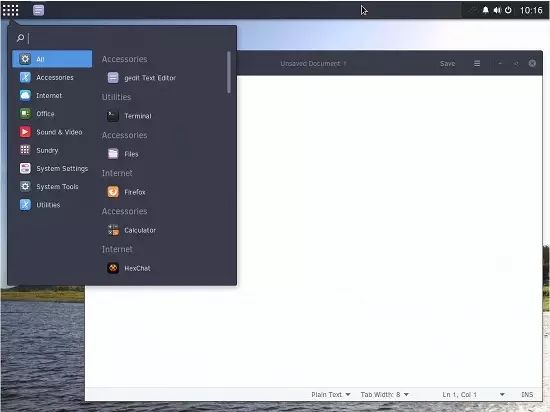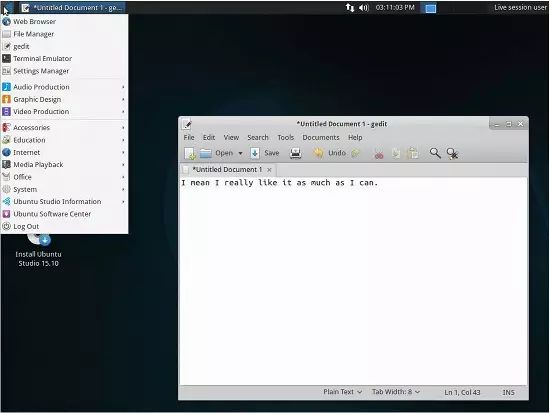 China’s largest open-source technology community www.oschina.net
China’s largest open-source technology community www.oschina.net
2015 was a significant year for Linux, both in enterprises and among consumers. As a user who has been using Linux since 2005, I can see that the operating system has come a long way over the past decade. And there are even more exciting things to come in 2016. In this article, I have selected some of the best Linux distributions that will shine in 2016.
Best Comeback: openSUSE
SuSE, the company behind openSUSE, is one of the oldest Linux companies; it was established just a year after Linus Torvalds released Linux. SuSE predates the Linux King, Red Hat. SUSE is also the sponsor of the community distribution openSUSE.
In 2015, the openSUSE team decided to get closer to SUSE Linux Enterprise (SLE), allowing users to share the DNA that can be allocated between the enterprise servers—similar to CentOS and Ubuntu. Thus, openSUSE was updated to the Leap version, which is directly based on SLE SP (Service Pack) 1.
The practice of sharing codebases between these two distributions is mutually beneficial, as SUSE will adopt excellent modules from openSUSE and vice versa. With this move, openSUSE has also abandoned the conventional release cycle, and a new version of SLE will be released simultaneously. This means that each version will have a longer lifecycle.
Due to this action, openSUSE has become a very important distribution, as potential SLE users can now use the Leap version of openSUSE. But that’s not all; openSUSE also announced a pure rolling release version—the Tumbleweed version. So now, users can choose between the super-stable Leap version of openSUSE or the always-up-to-date Tumbleweed version. In my impression, no other distribution has made such an impressive comeback.
Highly Customizable Distribution: Arch Linux
Arch Linux is the best rolling release. Okay, I might be a bit biased since I am an Arch Linux user. However, the reasons I mention are that Arch Linux excels in many areas, which is why I use it as my primary operating system.
-
Arch Linux is a massive Linux distribution for beginners. Because you have to manually install everything, you can learn all the bits and pieces in a system-based operating system.
-
Arch Linux is the most customizable version. There is no style of Arch version; you can take the underlying code and build any distribution on top of it. Unlike OpenSUSE or Ubuntu, there are no extra patches or integrations. You can get integrations created by upstream developers.
-
Arch Linux is one of the best rolling releases. I am always updating. Users are always running the latest packages, and they can also run pre-release software through unstable repositories.
-
Arch Linux also has good documentation. The Arch Linux Wiki is where I often go to get all Linux-related resources.
-
What I love most about Arch Linux is that it provides almost every package and software available from any Linux distribution, thanks to the Arch User Repository, also known as AUR.
Best Looking Distribution: elementary OS
Different distributions have different focuses, and in most cases, these are technical differences. In many Linux distributions, aesthetics are considered last—a fringe project relies on a specific desktop environment to support it.
elementary OS is trying to change that. Here, design is at the forefront for quite obvious reasons. This distribution is developed by those who once created beautiful icons in the Linux world and have left their mark.
elementary OS has a quite strict overall look and feel. The developers have created their own components, including the desktop environment. Moreover, they only select applications that fit the design paradigm. For Apple’s operating system, elementary OS has a profound influence.
Best Newcomer: Solus
This operating system has gained quite a bit of attention. It is a polished system created from scratch. It is not a derivative of Debian or Ubuntu. It comes equipped with the Budgie desktop environment, aimed at integrating with Gnome. It rivals the simplicity of Chrome OS.

I haven’t played with it much, but it looks promising. In fact, it is not a new operating system. It has existed in different forms and names for a while. But in 2015, the whole project returned under a new name.
Best Cloud Operating System: Chrome OS
Chrome OS may not be a system based on a typical Linux distribution, as it is an operating system that operates online based on a browser. However, because it is based on the Linux source code, anyone can edit it, making it a very appealing operating system. I use Chrome OS every day. It is an excellent, maintenance-free operating system that purely uses web-related resources and is constantly updated. Chrome OS, along with Android, is trustworthy for everyone to install on their personal computers and mobile devices.
Best Laptop Operating System: Ubuntu MATE
Most laptops do not have very high-end hardware, and if you run a truly resource-intensive desktop environment, you won’t make it; there are not many system resources and sufficient battery life—these will be consumed by the operating system itself. This led me to discover that Ubuntu MATE is an excellent operating system. It is extremely lightweight and offers a pleasant experience. Due to its lightweight design, most system resources are free for applications, allowing you to still perform some heavy work. I also found it to be a great distribution for low-end systems.
Best Distribution for Old Hardware: Lubuntu
If you have an old laptop or PC lying around, start a new life for them with Lubuntu. Lubuntu uses LXDE, but the project has merged with Razor-qt to create LXQt. Although the latest release 15.04 still uses LXDE, future versions will use LXQt. Lubuntu is a decent operating system for old hardware.
Core of the Internet of Things: Snappy Ubuntu Core
For devices like the Internet of Things (IoT), it is the best operating system based on Linux. This operating system has immense potential to turn nearly everything around us into smart devices, such as routers, coffee machines, drones, etc. The interesting part is that the management software updates and the provided integration packages are designed to enhance its security.
Best Desktop Distribution: Linux Mint Cinnamon
Linux Mint Cinnamon is the best operating system for desktops and powerful laptops. I like to call it the Mac OS X of the Linux world. Honestly, I am not a fan of Linux Mint Cinnamon due to its long-standing instability. However, as long as the developers choose to use it, the version will maintain its stability. Because the developers do not have to spend much time worrying about keeping up with Ubuntu’s updates, they now invest all their time into improving Linux Mint Cinnamon.
Best Gaming Distribution: Steam OS
Gaming has always been a weakness of desktop Linux. Many users install a dual-boot system of Linux + Windows just to be able to play games. Valve Software is trying to change this weakness. Valve Software is a game publisher that provides a client capable of running games across different platforms. Now, Valve Software has established its open operating system—Steam OS—to create a web-based gaming platform. By the end of 2015, partners began releasing Steam products to the market.
Most Privacy-Conscious Distribution: Tails
In the current era of mass surveillance and marketing tracking (anonymity tracking for content is acceptable), privacy has become a major issue. If you need to maintain business channels with government and marketing agencies, you need an operating system that considers privacy from the start.
So, nothing is better than Tails, which is designed for privacy. It is based on the Debian kernel and offers a design for privacy and anonymity. Tails is so good that it is reported that the National Security Agency even feels threatened by it.
Best Distribution for Multimedia Production: Ubuntu Studio
Multimedia production is one of the main weaknesses of Linux-based operating systems. All professional-level applications are only available for Windows or Mac OS X. Linux needs not only decent applications in audio/video but also a proper multimedia production system. It should use a lightweight desktop environment and precious system resources, like CPU and RAM, to use the system itself sparingly, leaving room for multimedia applications. The best Linux distribution for multimedia production is Ubuntu Studio. It uses Xfce and comes equipped with a wide range of audio, video, and image editing applications.

Best Enterprise Version: SLE/RHEL
Enterprise version customers fundamentally do not look at articles introducing Linux versions. They already know to choose Red Hat Enterprise Linux or SUSE Linux Enterprise. These two names have become synonymous with enterprise versions on servers. These companies are continuously pushing innovation that changes the world around us.
Best Server Versions: Debian/CentOS
If you are looking for a server operating system but cannot or do not want to pay subscription fees for RHEL or SLE, then there is no better choice than Debian or CentOS. When it comes to community-based servers, these distributions are the gold standard in the industry. Importantly, they offer long-term technical support, so you can rest assured without frequently upgrading your system.
Best Mobile Operating System: Plasma Mobile
While the Linux-based Android system dominates the mobile space, many open-source communities, including myself, still crave a version that can provide traditional Linux desktop applications on mobile devices. Meanwhile, if a community, rather than a company, releases a runnable version, it is a better version; users are still focused on it rather than the financial goals of the company. This gives hope for the development of KDE’s Plasma Mobile.
This is a version based on Kubuntu launched in 2015. Because the KDE community claims their products adhere to standards and open-source development, I am excited about the future of Plasma Mobile.
Best Distribution for ARM Devices: Arch Linux ARM
With the success of Android, we are now surrounded by ARM-powered devices (devices with ARM processors)—from Raspberry Pi to Chromebooks and Nvidia Shield. In the past, Intel and AMD processors were not written into traditional distributions and run these systems. Some distributions are targeted at ARM, but they are mostly for specific hardware, such as Raspbian for Raspberry Pi.Arch Linux is a purely community-based distribution. You can run it on devices like Raspberry Pi, Chromebooks, and Android devices, and NVIDIA Shield. What makes this version even more interesting is the Arch User Repository (AUR), where you can install many applications that you might not find on other distributions.
Conclusion
As I compiled this article, I was amazed. There is something for everyone in the world of Linux, which is quite exciting. If desktop Linux does not arrive this year, it doesn’t matter. We are happy with the moments we share with Linux!
This article is translated collaboratively by OSChina
Clickto read the original articlefor details

OSChina|ID:oschina2013

Scan to follow OSChina’s WeChat account
Delivering selected news for you every day
Also daily OSChina’s random notes